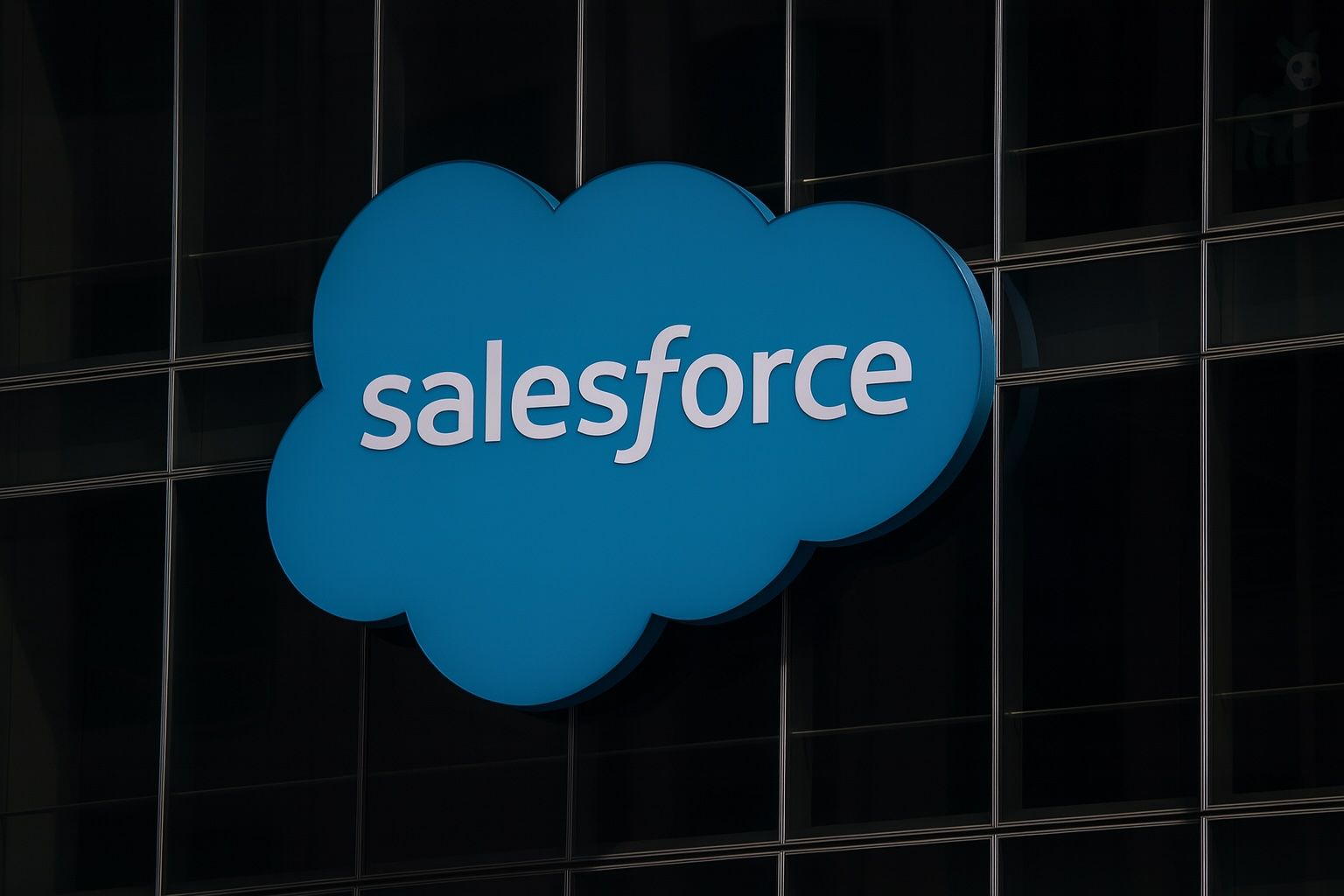- CRM stock jumps: Salesforce shares rallied almost 4% after the company unveiled an upbeat long-term outlook, trading around $245 on Friday. Despite the bounce, CRM is still down ~29% in 2025 [1], sharply underperforming peers and the broader market.
- Big AI ambitions: At its Dreamforce event, Salesforce raised its 2030 revenue target above $60 billion – beating Wall Street estimates – as it rapidly rolls out new AI features across its platform [2]. The forecast excludes a pending $8 billion Informatica acquisition aimed at boosting Salesforce’s AI and data capabilities [3].
- Mixed investor sentiment: A soft sales outlook last quarter had sent CRM to multi-month lows in early October [4] [5]. Now, fresh AI optimism is clashing with caution. Analysts’ price targets span from ~$221 to $405 [6] – reflecting bulls who see huge upside in AI-driven growth and bears who remain wary of near-term risks.
- AI and cloud moves: Salesforce is doubling down on generative AI. It launched “Agentforce” AI agents across its software suite and is embedding AI into everyday workflows – integrating ChatGPT into Slack and adding voice-enabled AI assistants for sales and service [7] [8]. An expanded partnership with OpenAI and Anthropic brings models like GPT-4 and Claude onto Salesforce’s platform, which executives herald as ushering in an “agentic AI era” [9].
- Context – headwinds and rivals: High interest rates and cautious IT spending have weighed on cloud stocks, pressuring Salesforce’s growth [10]. Meanwhile, competitors have surged: Oracle’s stock nearly doubled this year on the back of major AI cloud deals [11], and Microsoft is up ~20% in 2025, thanks to its AI lead. Salesforce’s valuation now looks relatively cheap at ~20× forward earnings vs. 31–32× for Microsoft and Oracle [12], suggesting any real turnaround could spark outsized gains.
Bumpy Ride for CRM Stock in 2025
Salesforce’s stock (NYSE: CRM) has been on a rollercoaster in recent weeks. After a steep September sell-off – when cautious guidance sent shares to multi-month lows around $235 [13] – the stock found a footing in the mid-$230s. Heading into mid-October, CRM began to stabilize. On October 16, shares surged about 4% after Salesforce issued a surprisingly strong long-term forecast, lifting the stock to roughly $246 by Thursday’s close [14]. That rebound comes as a relief to investors: even after the pop, CRM remains down roughly 27–29% year-to-date [15], a stark contrast to major indexes. In fact, Salesforce has lagged the S&P 500 by over 30 percentage points in the past year [16], dramatically underperforming many tech peers.
What’s behind the volatility? In part, macro pressures and earnings jitters. Earlier this year, Salesforce’s stock slid ~7% in one month after management issued soft revenue guidance, signaling that big AI bets have yet to fully translate into near-term growth [17]. The shares hit a 52-week low in the mid-$230s, far below their pandemic-era highs (near $370 in late 2021), underscoring how much investor sentiment cooled [18]. “We had an outstanding quarter, on track for record cash flow,” CEO Marc Benioff said in August, after Salesforce beat Q2 estimates with 10% revenue growth [19]. But Benioff’s optimism was tempered by reality – conservative guidance for the fall quarter triggered an immediate sell-off [20]. That pattern of solid results followed by wary outlooks has kept traders on edge.
Despite 2025’s rough performance, some see a turnaround forming. Salesforce’s beta is ~1.2 – meaning the stock tends to swing more than the market – so it often outpaces on up days and falls harder on down days [21]. The recent rally on October 16 hints that investors are willing to buy on good news. However, CRM has not yet broken through key technical levels. The stock is still trading below its major moving averages, and it sits well under its year’s high in the upper $200s [22]. Analysts note that clearing those resistance levels could “trigger a rapid influx of capital” and confirm a trend reversal, but for now caution prevails [23]. In short, Salesforce’s share price is off the canvas but not out of the woods – with bulls and bears locked in a tug-of-war over its next direction.
AI Ambitions: Salesforce’s $60 Billion Promise
A major spark for the latest rally was Salesforce’s bold new 2030 revenue forecast. At its annual Dreamforce conference, the cloud giant projected over $60 billion in revenue by FY2030, topping Wall Street’s ~$58 billion consensus [24]. This long-term target, presented at an investor day on Oct. 16, sent a strong message: Salesforce is convinced its heavy investments in artificial intelligence will pay off in spades. “Revenue is now accelerating, and the forecasts are rising,” observed MarketBeat analyst Thomas Hughes, adding that Salesforce’s long-awaited inflection point may finally be here [25].
Crucially, Salesforce’s $60B projection excludes the impact of its pending Informatica acquisition [26]. In May, Salesforce agreed to buy Informatica – a data management and integration software maker – for about $8 billion [27]. The deal (expected to close by early 2026) aims to supercharge Salesforce’s AI capabilities by incorporating Informatica’s advanced data tools into the platform [28]. It’s one of Salesforce’s largest acquisitions since Slack, and underscores CEO Marc Benioff’s strategy: bolster the company’s “Customer 360” platform with more data and AI, even as organic growth has slowed. Investors cheered the long-term vision – shares jumped in after-hours trading once the news hit [29] – but executing on it will be key to regaining market confidence.
Salesforce is certainly doubling down on AI. This year it rolled out Agentforce 360, described as a new framework of autonomous AI “agents” embedded throughout Salesforce’s cloud apps [30] [31]. At Dreamforce 2025, Benioff and CTO Parker Harris unveiled a slew of AI features aimed at automating routine tasks and boosting customer productivity. “We are truly in the agentic AI era,” said co-founder Harris, predicting that “40% of the work in the Fortune 1000 is probably going to be done by AI, [with] humans and AI working together” [32]. To make that a reality, Salesforce is integrating generative AI into every corner of its ecosystem:
- ChatGPT and Slack integration: In a landmark partnership with OpenAI, Salesforce will let customers access its Agentforce AI tools directly within ChatGPT [33]. Sales teams, for example, could ask ChatGPT to pull up Salesforce data or draft a proposal on the fly. At the same time, Slack (owned by Salesforce) is becoming the new “AI-powered” interface for the platform [34]. Users will be able to interact with Salesforce via Slack bots and a real-time search API, while an AI “Channel Expert” monitors Slack conversations to answer questions instantly [35]. Even OpenAI’s CEO Sam Altman chimed in on the alliance, calling it “an important step in how AI can improve daily workflows” [36].
- Voice and commerce AI: Salesforce introduced Agentforce Voice, an AI assistant that can talk to customers over phone systems, integrated with partners like Amazon Connect [37]. In demos, the AI voice could handle basic support calls or IT helpdesk queries, then hand off to a human if needed. The company also previewed an AI-driven “Instant Checkout” for online shopping – essentially an autonomous e-commerce agent built with OpenAI and Stripe – aiming to simplify purchases into a single chat interaction [38]. These moves extend Salesforce’s AI reach from text chat into voice and transactions, areas where rivals like Amazon and Oracle have also been investing.
- AI ecosystem partnerships: Beyond OpenAI’s GPT-4, Salesforce expanded ties with Anthropic to bring its Claude AI model into Salesforce’s platform, especially for regulated industries [39]. It opened up Slack and its Data Cloud with new APIs so that outside developers (from startups to Google) can build custom AI agents on Salesforce [40]. This strategy of being an AI “platform of platforms” is meant to cement Salesforce’s role at the center of enterprise AI adoption. The upside could be significant: by embedding itself in AI workflows, Salesforce hopes to drive double-digit percentage revenue growth again and dramatically boost margins by automating more of its services [41] [42].
The company is pairing these innovations with a focus on profitability. Salesforce launched a “Profitable Growth” plan branded “50 by FY30”, aiming for a combination of steady double-digit revenue growth and 50% non-GAAP operating margins by 2030 [43]. For context, Salesforce’s operating margin was in the mid-20s% range recently, so a 50% target is ambitious – on par with the most efficient enterprise software firms. Still, executives sound confident. They project free cash flow to triple over the next five years, fueled by the AI push and disciplined spending [44]. To underscore that confidence, Salesforce’s board authorized a $7 billion accelerated share buyback over the next six months [45] – roughly 3% of the company’s market cap – essentially betting that the current stock price is a bargain. Such aggressive buybacks, funded by robust cash flows, signal management’s belief that better days are ahead.
Wall Street: Cautious Optimism Amid Divided Outlooks
The flurry of AI news has drawn a mixed reaction from analysts and investors. Sentiment on Wall Street is cautiously optimistic, but not uniformly so. In the past week, several analysts reiterated bullish stances on CRM – often accompanied by hefty price targets – while a few others remain on the sidelines. For instance, on October 17 JMP Securities reaffirmed its “Market Outperform” rating with an eye-popping $430 price target [46]. That is one of the Street’s highest targets and implies the stock could nearly double. Likewise, Wedbush’s tech guru Dan Ives (a noted AI bull) has an Outperform rating and recently held a target around $375 [47], voicing confidence that Salesforce’s AI momentum will “enter a new gear” into 2025. Needham and Cantor Fitzgerald also reiterated Buy/Overweight ratings, seeing CRM as significantly undervalued if it can execute on AI, with targets in the $325–$400 range [48].
Not everyone is convinced, however. Both Macquarie and DA Davidson stuck to “Neutral” ratings on Salesforce in mid-October [49]. Their price targets (around $225–$250) suggest little upside from current levels. These more cautious analysts point to Salesforce’s relatively slow growth in recent quarters – about 11% YoY last quarter – and lingering questions about monetizing its new AI products. Indeed, while Salesforce topped Q2 earnings, its Q3 guidance came in below estimates [50], hinting that clients are taking time to ramp up spending on AI features given the cloudy economic climate. RBC Capital Markets has noted that earlier fanfare around Salesforce’s Agentforce AI platform “has moderated”, as enterprises navigate from pilot projects to actual deployments [51]. In other words, there’s excitement about AI, but also a recognition that transforming that into revenue is a gradual process.
The consensus 12-month outlook for CRM stock sits in between the extremes. According to a Refinitiv survey, the average analyst price target is around $330 – roughly 35% above the current price [52]. That average reflects a wide range from a low in the low $220s up to highs around $400+ [53], highlighting just how divided opinions are. Overall, about 80% of analysts rate Salesforce a Buy or Outperform [54], indicating general confidence in the company’s direction. However, many are taking a “show me” approach: they want to see evidence that Salesforce’s big AI bet translates into accelerating sales growth or expanding margins in coming quarters. Until then, the stock may remain in a holding pattern, oscillating with each new data point.
The investor base also reflects this cautious optimism. Institutional investors – who own over 80% of CRM shares – have been net buyers throughout 2025, even as the stock fell [55]. MarketBeat data shows roughly $1.50 in institutional money flowed into CRM for every $1 that left over recent months [56]. That accumulation indicates many large investors see value at these depressed prices. However, there have been some red flags. Salesforce insiders (executives and directors) reportedly sold about $9 million in stock in late summer, shortly after the last earnings [57]. While not enormous for a $230+ billion company, those insider sales drew attention – possibly signaling that management saw the stock’s earlier rebound as a good time to take profits. Salesforce downplayed the significance, and it’s worth noting insiders still hold plenty of shares. But the timing, just ahead of the big AI announcements, gave a few investors pause about the near-term upside.
For now, all eyes are on execution. As one analyst quipped, “The bears cannot see AI in their spreadsheets.” Salesforce will need to prove the AI hype with hard numbers – new customer wins, rising subscription revenues, and maybe an uptick in that ~10% growth rate. The next earnings report (covering the quarter with Dreamforce and initial AI launches) will be a crucial checkpoint. If Salesforce can show that its new AI products are gaining traction or that its “AI + efficiency” strategy is boosting profit margins, even some skeptics might come around. On the other hand, any stumble or slower adoption could reinforce the cautious case.
Macro Clouds and Competitive Fire
Salesforce’s trajectory in 2025 can’t be separated from the broader market forces at play. The company has been navigating a tricky macroeconomic landscape marked by rising interest rates, IT budget tightening, and geopolitical jitters. As Reuters noted, enterprise cloud providers like Salesforce are under pressure to “show returns on the billions poured into AI” [58] at a time when many customers are scrutinizing spend. Economic uncertainty and volatile customer spending have undeniably weighed on Salesforce’s growth [59]. Since mid-2024, the firm’s revenue growth decelerated into the high-single to low-double digits – a comedown from the heady 20%+ growth years. Some clients delayed software projects or opted for smaller deals, citing caution about the economy. Salesforce responded with cost discipline (including layoffs earlier in the year) and by emphasizing how its AI features can deliver productivity gains that justify the investment.
There are signs the macro headwinds may be easing. U.S. bond yields, which spiked to multi-year highs and put pressure on high-valuation tech stocks, have recently pulled back – the 10-year Treasury yield dipped near 4.0% this week [60]. That has given a lift to the tech sector. Investors are also betting that the Federal Reserve is done raising rates and could even cut rates in 2024 if inflation continues to cool [61]. Such a shift would be a boon for growth stocks like Salesforce, making future profits more valuable. Additionally, early earnings reports from big companies have been decent, and there’s optimism that a feared economic hard landing might be avoided. Salesforce’s own results will feed into this narrative: a re-acceleration in its business would signal that corporate tech spending is recovering, whereas any weakness could stoke broader concerns.
Meanwhile, competition in cloud software and AI is heating up – and Salesforce faces formidable rivals on multiple fronts. Perhaps most dramatically, Oracle has emerged as an unlikely stock market star this year. Oracle’s focus is different (database and cloud infrastructure), but it has aggressively courted AI workloads and enjoyed windfall gains. In September, Oracle stunned the market by revealing huge cloud deals, including a reported $300 billion contract with OpenAI for cloud capacity [62]. Oracle’s stock soared as much as 43% in a single day on the news, hitting record highs around $345 [63]. Year-to-date, Oracle shares have risen roughly 80–90% – briefly bringing its market cap near $900 billion [64] [65]. This surge not only made Larry Ellison one of the world’s richest men, but also highlighted the market’s appetite for credible AI success stories. Microsoft, too, has seen its stock climb about 20% in 2025, after a 58% jump last year [66] [67]. Microsoft’s deep ties to OpenAI (and integration of GPT-4 across Azure and Office) have kept investors excited about its AI prospects. Even Google and Amazon, despite some recent stumbles, are leveraging their cloud divisions and AI research to compete for enterprise dollars.
Where does that leave Salesforce? In a strong, if challenging, position. Salesforce remains the world’s #1 provider of customer relationship management software by a wide margin – it commands roughly 24% of the CRM market, more than the next four competitors combined [68]. Its product ecosystem (Sales Cloud, Service Cloud, Marketing Cloud, Tableau, Slack, etc.) is entrenched in many large organizations. This installed base gives Salesforce a long runway to upsell new AI features. However, rivals are encroaching on its turf. Microsoft’s Dynamics 365 platform has been gaining ground in sales and marketing software, aided by bundling with other Microsoft apps. Oracle, Adobe, SAP, and others all pitch their own customer experience clouds and AI-enhanced analytics. Even startups and niche players, often specializing in a particular industry or function, nip at Salesforce’s heels.
Salesforce’s answer is to leverage its scale and trust. The company touts that it serves 90%+ of Fortune 500 companies [69], positioning itself as the safe choice for enterprises looking to implement AI responsibly. Its new “trust layer” for AI – ensuring data privacy and model transparency – is a selling point for wary CIOs. Furthermore, Salesforce’s massive partner network (global consulting firms, ISVs, etc.) acts as a force multiplier in delivering its solutions worldwide. Still, as the AI gold rush continues, Salesforce will need to innovate quickly to stay ahead. One intriguing angle is that Salesforce is now a Dow Jones component (added in 2020), whereas many high-growth cloud peers are not. This means some investors view CRM as a more mature value play rather than a pure growth stock. Striking the right balance between growth and profitability is thus crucial to attract both mindsets.
Outlook: Cautious Hope for a Turnaround
As of mid-October 2025, the mood around Salesforce is one of cautious hope. The stock’s recent bounce off its lows and the company’s confident 2030 forecast have given investors reason to believe the worst may be over. Market sentiment is improving: talk of a “tech rally” is back as AI optimism combines with expectations of easier monetary policy. Salesforce has positioned itself at the heart of the AI-in-enterprise narrative, and that could re-energize its stock if the narrative delivers tangible results.
Yet skepticism hasn’t vanished. Salesforce is playing a long game with AI, and not every shareholder is patient. In the coming months, look for a few key developments:
- Financial performance: Hitting (or beating) the current quarter’s targets, and any uptick in the full-year outlook, would validate management’s optimism. Watch especially for AI-related metrics – e.g. growth in Data Cloud or MuleSoft usage, or new customer wins attributed to Agentforce. The company’s pledge of >10% annual growth through FY2026–FY2030 [70] will need early proof points.
- Product adoption: Salesforce has made bold claims about agentic AI. Any case studies or data showing that customers are actually deploying Agentforce at scale (and paying for it) would be hugely positive. Conversely, if AI features languish in pilot mode (the dreaded “95% of AI projects fail to leave pilot” scenario [71]), the market may sour again.
- Competitive wins or losses: Investors will keep an eye on the competitive landscape. For example, if Oracle’s momentum in cloud infrastructure continues, could it start to steal Salesforce’s thunder in certain accounts? Or might Salesforce’s partnerships (with companies like Google or AWS, who are Oracle’s rivals) help it counter that? Any signal of market share shifts in the CRM or business software domain will be scrutinized. Fortunately for Salesforce, its core franchise is still robust – enterprise customers are typically reluctant to rip out their CRM systems, especially after investing in customizations. This gives Salesforce some insulation, but not immunity.
- Macroeconomic signals: Finally, the broader tech market will influence CRM’s ride. Signs of inflation easing or a Federal Reserve pivot would likely lift Salesforce along with its peers. On the other hand, any surprise rate spikes or economic shocks (e.g. a geopolitical crisis or a sudden downturn in corporate spending) could renew pressure on high-valuation names, Salesforce included. The company’s relatively lower valuation multiple now – about 20× forward earnings – could buffer it somewhat, as a lot of pessimism is arguably “priced in” [72]. Indeed, Salesforce’s stock trades at a discount to most big-cap software rivals, which could attract value-oriented buyers if growth stabilizes.
For now, Salesforce’s story is at a crossroads. The company is preaching a message of “AI-driven growth and disciplined execution” to turn its fortunes. It has laid out bold goals ($60B+ revenue, 50% margins) and is throwing its weight behind innovations that only a few years ago sounded like science fiction. The next year will test whether Salesforce can transform from a cloud pioneer maturing out of its high-growth phase into an “AI era” leader that accelerates again. If it succeeds, today’s stock slump could become tomorrow’s opportunity – as some analysts put it, an “extreme bargain in plain sight.” If it stumbles, however, Salesforce could remain stuck in the market’s penalty box, overshadowed by flashier success stories.
For investors and the general public alike, Salesforce’s journey underscores a broader theme of 2025: the balance between hype and reality in the AI revolution. Marc Benioff’s company has bet big that it can harness AI to deliver real business value at immense scale. As the year winds down, CRM shareholders are hoping that bet will start to pay off – and that Salesforce’s stock can finally rejoin the market’s winners.
Sources: Salesforce and ts2.tech news updates [73] [74]; Reuters and Yahoo Finance reports [75] [76]; TechStock² analysis [77] [78]; MarketBeat/Investing.com commentary [79] [80]; Reuters coverage of Oracle’s AI surge [81] [82]; GuruFocus analyst ratings recap [83] [84].
References
1. www.reuters.com, 2. www.reuters.com, 3. www.reuters.com, 4. ts2.tech, 5. ts2.tech, 6. ts2.tech, 7. ts2.tech, 8. ts2.tech, 9. ts2.tech, 10. www.reuters.com, 11. www.reuters.com, 12. ts2.tech, 13. ts2.tech, 14. www.reuters.com, 15. www.reuters.com, 16. ts2.tech, 17. ts2.tech, 18. ts2.tech, 19. ts2.tech, 20. ts2.tech, 21. ts2.tech, 22. ts2.tech, 23. www.investing.com, 24. www.reuters.com, 25. www.investing.com, 26. www.reuters.com, 27. www.reuters.com, 28. www.reuters.com, 29. www.reuters.com, 30. ts2.tech, 31. ts2.tech, 32. ts2.tech, 33. ts2.tech, 34. ts2.tech, 35. ts2.tech, 36. ts2.tech, 37. ts2.tech, 38. ts2.tech, 39. ts2.tech, 40. ts2.tech, 41. www.investing.com, 42. www.investing.com, 43. ts2.tech, 44. www.investing.com, 45. www.reuters.com, 46. www.gurufocus.com, 47. www.gurufocus.com, 48. www.gurufocus.com, 49. www.gurufocus.com, 50. www.reuters.com, 51. ts2.tech, 52. www.gurufocus.com, 53. ts2.tech, 54. www.gurufocus.com, 55. www.investing.com, 56. www.investing.com, 57. ts2.tech, 58. www.reuters.com, 59. www.reuters.com, 60. ts2.tech, 61. ts2.tech, 62. www.reuters.com, 63. www.reuters.com, 64. www.reuters.com, 65. www.reuters.com, 66. totalrealreturns.com, 67. totalrealreturns.com, 68. ts2.tech, 69. www.investing.com, 70. ts2.tech, 71. ts2.tech, 72. ts2.tech, 73. www.reuters.com, 74. ts2.tech, 75. www.reuters.com, 76. www.reuters.com, 77. ts2.tech, 78. ts2.tech, 79. www.investing.com, 80. www.investing.com, 81. www.reuters.com, 82. www.reuters.com, 83. www.gurufocus.com, 84. www.gurufocus.com







